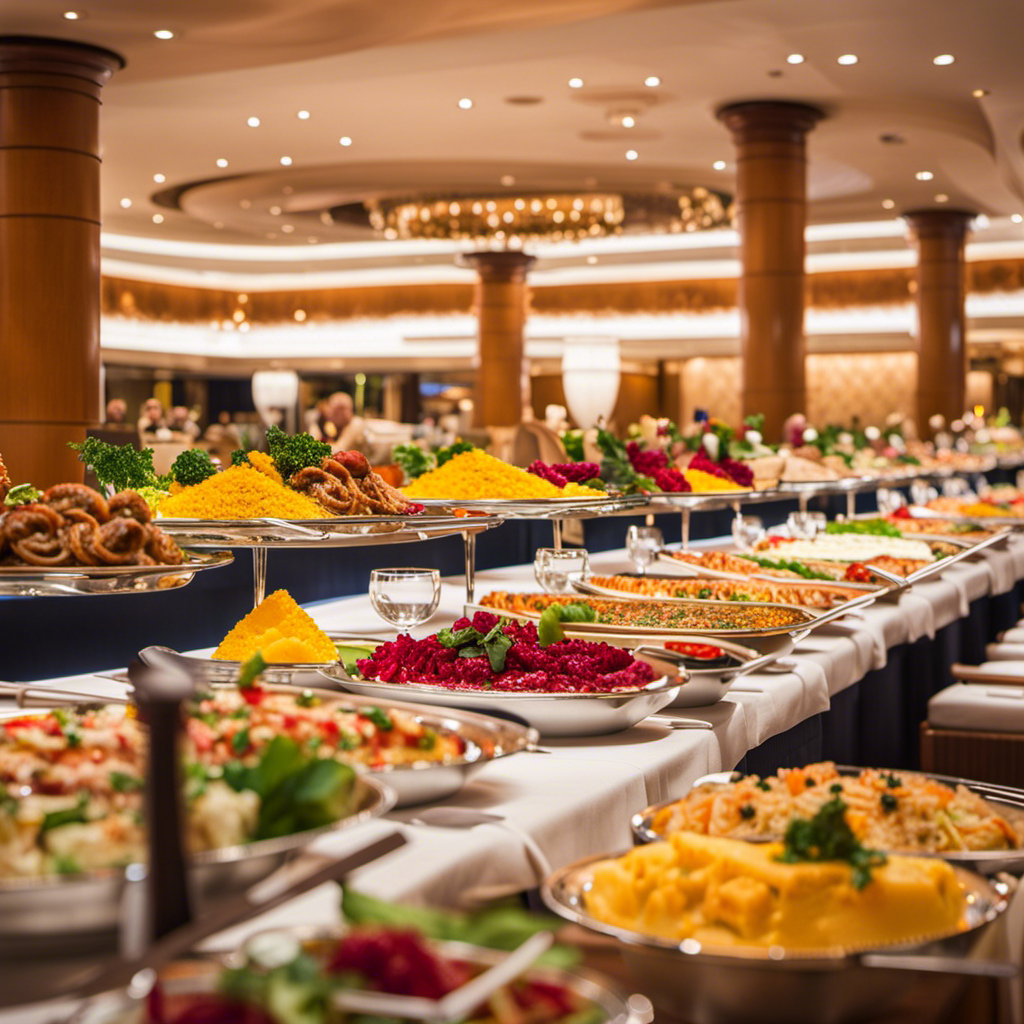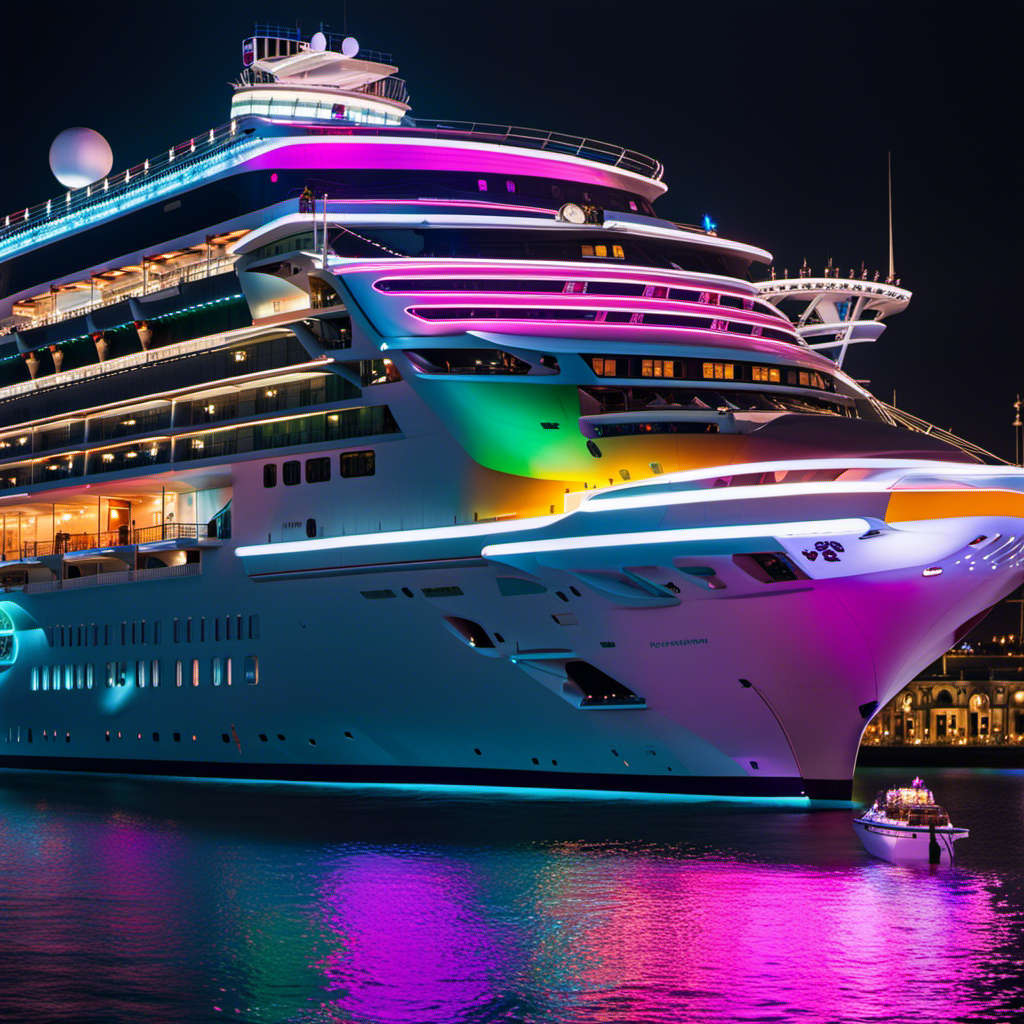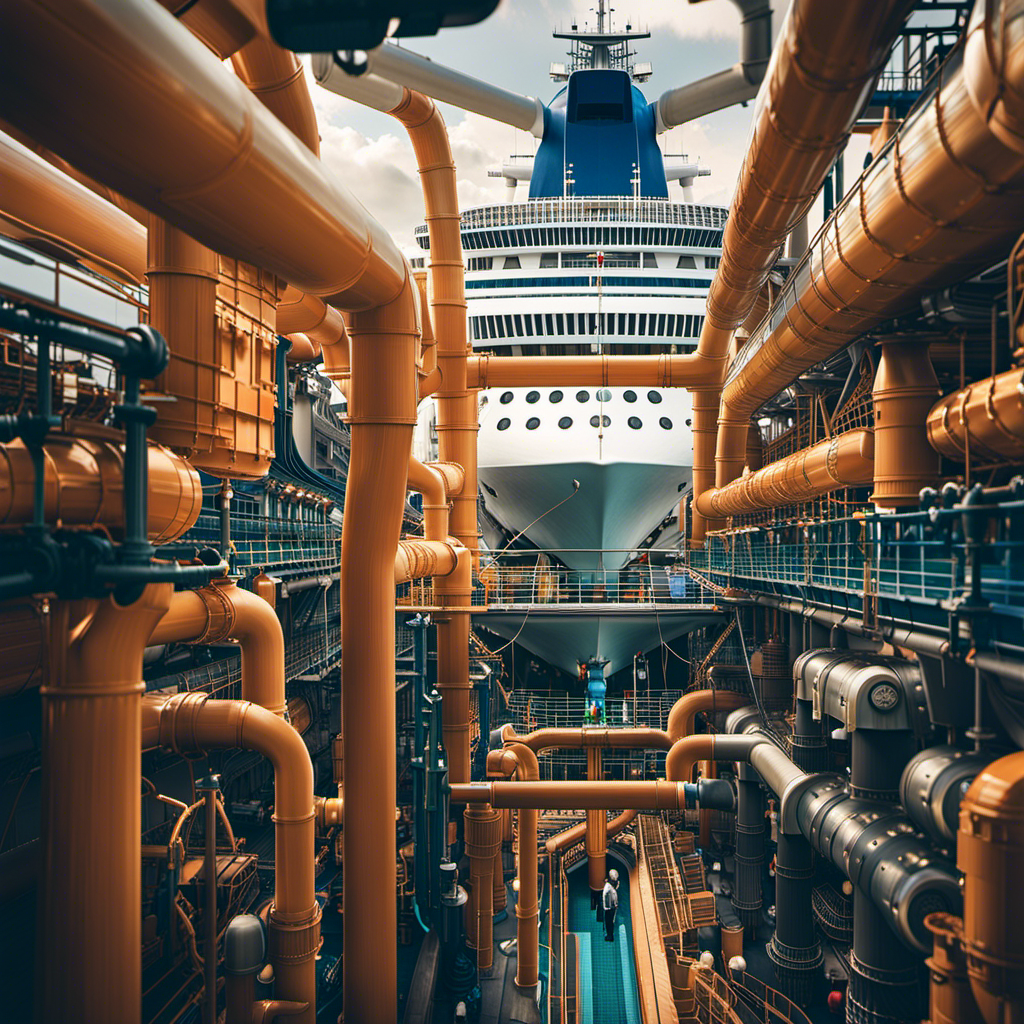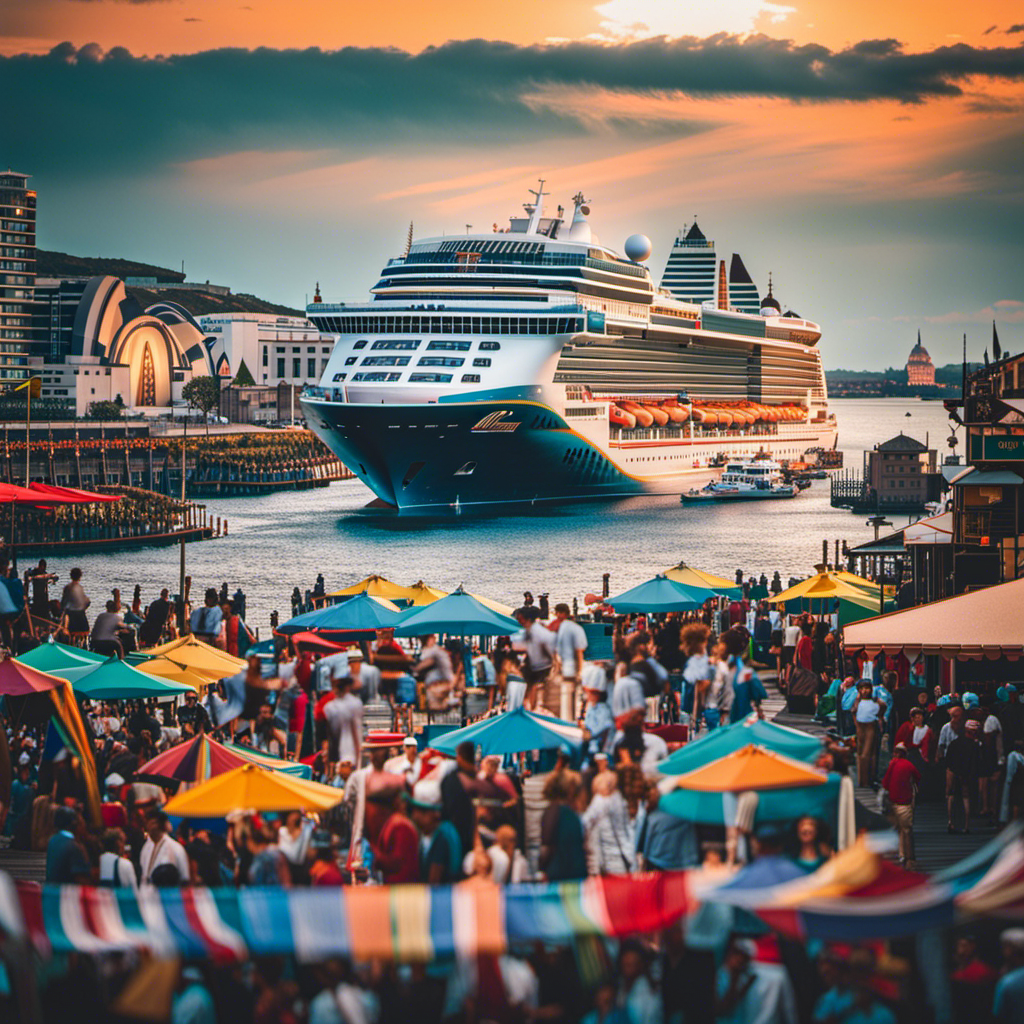Stepping onto the magnificent cruise ship, I am immediately embraced by the tantalizing aroma of fine dining, beckoning me to embark on a splendid journey for my palate. Ah, the evolution of dining experiences aboard cruise ships!
From the days of assigned tables and buffet lines, we now find ourselves in a world of endless options. Specialty restaurants abound, catering to every palate imaginable. From succulent steaks to mouthwatering sushi, the choices are as vast as the open sea.
Join me as we explore the evolution of cruise ship dining and savor the delightful variety that awaits.
Key Takeaways
- Cruise ship dining has evolved from assigned tables and buffet options to offering a dozen or more dining options, including specialty restaurants.
- Specialty restaurants cater to different tastes and preferences, providing guests with a vast array of choices and the opportunity to try different cuisines.
- The availability of dining choices is a major selling point for many cruise ships, but not everyone appreciates the multitude of options and some prefer simplicity and peace during their vacation.
- Traditional dining options still exist, but they may be overshadowed by the variety of choices, leading some individuals to opt for alternative vacation options to avoid dining conflicts.
From Assigned Tables to Abundant Options
From my personal experience, I have seen the cruise industry evolve from assigned tables to a delightful abundance of dining options.
Cruise ship dining trends have shifted dramatically over the years, reflecting changing preferences of passengers. In the past, guests were typically assigned to a specific table and dining room for the duration of their cruise. The only alternative was the buffet or grill options.
However, today’s megaships offer a dozen or more dining options, ranging from specialty restaurants like steakhouses, Italian, sushi, Mexican, Asian fusion, to burger joints. Some restaurants are complimentary, while others have surcharges. Even smaller ships now offer alternative dining choices.
This variety of dining options caters to different tastes and preferences, making it a major selling point for many cruise ships.
A Culinary Voyage: Exploring Specialty Restaurants
I highly recommend exploring the specialty restaurants on a cruise for a culinary voyage like no other. These restaurants offer unique dining experiences that allow you to explore cuisines from around the world. Whether you’re in the mood for a juicy steak, authentic Italian pasta, fresh sushi, spicy Mexican dishes, or innovative Asian fusion, there is something to satisfy every palate.
The variety of dining choices on a cruise ship is truly impressive, with megaships offering a dozen or more options. From complimentary restaurants to those with surcharges, you have the opportunity to try a wide range of flavors and culinary creations.
The specialty restaurants on a cruise ship provide a delightful and unforgettable dining experience that adds an extra level of enjoyment to your vacation. So, embark on a culinary adventure and indulge in the unique dining experiences that these restaurants have to offer.
Traditional Vs. Adventurous: Catering to Different Tastes
Catering to different tastes, traditional dining options with set dinner times still exist on cruise ships. However, alongside these traditional choices, there is a world of adventurous cuisine awaiting those who seek it. Here are three reasons why the variety of dining options on cruise ships is a delight for every palate:
-
Traditional Dining: For those who prefer a more structured dining experience, traditional dining options offer the familiarity of one dining room and set dinner times. It provides a sense of routine and the chance to build relationships with fellow passengers.
-
Adventurous Cuisine: On the other hand, if you are a culinary explorer, cruise ships offer a plethora of specialty restaurants that cater to your taste buds. From steakhouses to sushi bars, Italian trattorias to Mexican cantinas, the options are endless. You can indulge in a world of flavors and try something new every night.
-
The Best of Both Worlds: With the variety of dining choices available, you can have the best of both worlds. You can enjoy the comfort of traditional dining on some nights and venture into the realm of adventurous cuisine on others. It allows you to tailor your dining experience to your mood and preferences.
Whether you prefer the familiarity of traditional dining or the excitement of trying new and exotic dishes, cruise ships have something for everyone. So, embark on a culinary journey and let your taste buds be your guide.
The Allure of Endless Choices: A Major Selling Point
The multitude of dining options on cruise ships is a major selling point for many travelers, offering a wide range of choices to suit every taste and preference. It’s like stepping into a food lover’s paradise, with a variety of restaurants and cuisines to explore.
From elegant fine dining establishments to casual buffet-style eateries, there’s something for everyone. But what makes these dining options even more appealing are the benefits of dining packages. These packages often include specialty restaurants, allowing guests to experience a taste of luxury without any additional charges.
Additionally, cruise ships are well-equipped to cater to dietary restrictions. Whether you’re gluten-free, vegetarian, or have food allergies, the staff onboard are trained to accommodate your needs. So, even with dietary restrictions, you can still indulge in a gastronomic adventure at sea.
Navigating the Challenges of Dining Decisions
Navigating the multitude of dining choices on a cruise ship can be a challenge, especially when trying to accommodate different preferences and dietary restrictions.
Finding dining harmony can be a daunting task. Balancing the desires of individuals within a group can lead to conflicts. Deciding between traditional dining or exploring specialty restaurants can be a tough decision.
As someone who has experienced this firsthand, I understand the struggles. Personally, I love the variety and excitement of trying different cuisines in the specialty restaurants. However, I also acknowledge that not everyone shares the same enthusiasm.
One coworker, for example, preferred the simplicity of traditional dining with one dining room and set dinner times. They valued having one waiter who understood their specific preferences. Ultimately, to avoid dining conflicts, they chose a different vacation option.
In the end, it’s important to consider and respect the different preferences and experiences of individuals when navigating the dining choices on a cruise ship.
Personal Perspectives: Embracing Variety or Seeking Simplicity
As someone who has experienced the multitude of dining choices on a cruise ship, I can appreciate the diversity of preferences when it comes to embracing variety or seeking simplicity.
On one hand, there are those who relish the opportunity to explore a vast array of dining options, from steakhouses to sushi bars, Italian to Mexican cuisine. The availability of specialty restaurants is a major selling point for many cruise ships, offering guests the chance to try different cuisines and satisfy their adventurous palates.
On the other hand, some individuals prefer the simplicity and peace of traditional dining, with one dining room and set dinner times. For them, having one waiter who understands their specific preferences is of utmost importance.
Personal preferences and dining conflicts can arise when families or groups have differing views on dining experiences. It is important to acknowledge and respect the different perspectives and experiences of individuals when it comes to embracing variety or seeking simplicity in cruise ship dining.
Ultimately, the choice lies in finding the perfect balance between culinary exploration and personal preferences.
Expert Insights: A Cruise Writer’s Experience and Recommendations
From my years of experience as a cruise writer, I have found that the key to a satisfying dining experience lies in finding the perfect balance between culinary exploration and personal preferences.
As a cruise writer, I have had the opportunity to sample a wide variety of dining options on various cruise ships. From the traditional elegance of a main dining room to the vibrant flavors of specialty restaurants, there is something to suit every palate.
My top dining recommendation would be to embrace the variety and try different cuisines offered onboard. Whether it’s a juicy steak in a steakhouse or a plate of sushi in a Japanese restaurant, these specialty dining venues provide a unique and memorable experience.
However, I also understand that some individuals prefer simplicity and peace during their vacation, and for them, sticking to the traditional dining options may be the best choice.
Ultimately, the decision comes down to personal preference, and as a cruise writer, I aim to provide information and suggestions to help individuals make the best dining choices for their cruise vacation.
Savoring the Evolution: A Delightful Journey for Every Palate
I’ve had the pleasure of experiencing the diverse culinary journey available on modern cruise ships. From the moment you step on board, you are greeted with an array of dining options that cater to every palate. It’s a true culinary exploration, where you can savor the flavors of different cuisines from around the world.
Whether you’re in the mood for a juicy steak, fresh sushi, or authentic Italian pasta, there is a specialty restaurant on board that will satisfy your cravings. The variety of choices is astounding, and each restaurant offers a unique dining experience.
As you indulge in these delectable meals, you can’t help but be amazed at the quality of the food and the attention to detail. The chefs on board are truly talented, and they take great pride in creating dishes that not only taste incredible but also look like works of art.
Frequently Asked Questions
What Are Some Examples of Specialty Restaurants Found on Modern Cruise Ships?
On modern cruise ships, you can find specialty restaurants with celebrity chefs and unique cuisines. From steakhouses to sushi bars, there’s something for every palate. These dining options add an extra layer of excitement to the cruise experience.
How Do the Surcharges for Specialty Restaurants on Cruise Ships Vary?
The surcharges for specialty restaurants on cruise ships vary depending on the dining experience. From $10 to $75 per person, guests can indulge in a delightful variety of cuisines, with all-inclusive dining options available.
Are There Any Cruise Lines That Still Offer Traditional Dining With One Dining Room and Set Dinner Times?
Yes, there are still cruise lines that offer traditional dining with one dining room and set dinner times. Guests can enjoy a more simplistic and peaceful dining experience compared to the vast array of choices available on other ships.
What Are Some Alternative Vacation Options for Individuals Who Prefer Simplicity and Peace During Their Vacation?
For those seeking simplicity and peace during their vacation, there are alternative options available such as simplistic retreats and tranquil getaways. These destinations offer a serene environment that allows individuals to relax and unwind.
How Can a Cruise Writer’s Experience and Expertise Assist Individuals in Planning Their Cruise Vacation?
Cruise writer’s insights and expert tips can greatly assist individuals in planning their cruise vacation. With my experience and expertise, I can provide valuable information, suggestions, and recommendations to ensure a memorable and enjoyable trip.
Claire, a creative soul with an unquenchable thirst for storytelling, is an integral part of the Voyager Info team. As a dedicated writer, she weaves captivating narratives that transport readers to enchanting cruise destinations and beyond.
Claire’s love affair with writing began at an early age when she discovered the magic of words and their ability to craft worlds and emotions. Her innate curiosity led her to explore various literary genres, but it was travel writing that truly captured her heart. Drawing inspiration from her own globetrotting adventures and encounters with diverse cultures, Claire embarked on a journey to become a travel writer par excellence.











